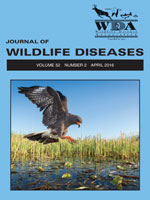In Canada, Francisella tularensis, the zoonotic bacterial agent of tularemia, affects mostly snowshoe hares (Lepus americanus), muskrats (Ondatra zibethicus), and beavers (Castor canadensis). Despite numerous studies, the ecologic cycle and natural reservoirs of F. tularensis are not clearly defined. We conducted a cross-sectional study to estimate the prevalence of F. tularensis in snowshoe hares, muskrats, and coyotes (Canis latrans) in four regions of Québec, Canada, and to describe the risk of infection in relation to host and environmental characteristics at three spatial scales. Between October 2012 and April 2013, trappers captured 345 snowshoe hares, 411 muskrats, and 385 coyotes. Blood samples were tested by microagglutination tests, and DNA extracts of liver, kidney, lung, and spleen of snowshoe hares and muskrats were tested by real-time PCR to detect past and active infection to F. tularensis, respectively. Individual host characteristics, including body condition, age, and sex, were evaluated as risk factors of infection, along with ecologic characteristics of the location of capture extracted from geographic databases. Prevalences of antibody to F. tularensis and 95% confidence intervals were 2.9% (1.4–5.1%) in coyotes, 0.6% (0.1–2.1%) in hares, and 0% (0.0–0.9%) in muskrats. Francisella tularensis DNA was not detected by real-time PCR in the pools of four organs from muskrats and hares, but F. tularensis type AI was detected during testing of the individual organs of two antibody-positive hares. Exact logistic regression analyses showed that age was a significant predictor of antibody detection in coyotes, as were the proportion of forest and the proportion of area considered as suitable habitat for hares in the environment around the location of capture of the coyotes. Our results suggest a terrestrial cycle of F. tularensis in the regions studied.
How to translate text using browser tools
1 April 2016
ECO-EPIZOOTIOLOGIC STUDY OF FRANCISELLA TULARENSIS, THE AGENT OF TULAREMIA, IN QUÉBEC WILDLIFE
Vanessa Gabriele-Rivet,
Nicholas Ogden,
Ariane Massé,
Kym Antonation,
Cindi Corbett,
Antonia Dibernardo,
L. Robbin Lindsay,
Patrick A. Leighton,
Julie Arsenault
ACCESS THE FULL ARTICLE

Journal of Wildlife Diseases
Vol. 52 • No. 2
April 2016
Vol. 52 • No. 2
April 2016
coyote
Francisella tularensis
microagglutination test
muskrat
PCR
prevalence
risk factor




